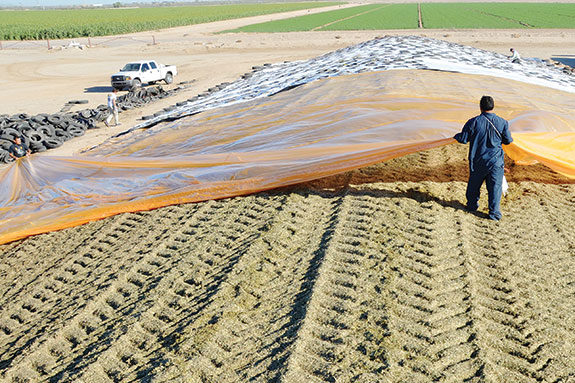Money is lost from both spoiled silage, which has to be discarded, and from the decreased nutritional value of the silage itself.
However, these losses are unnecessary and preventable.
When it comes time to seal bunker silos or drive-over piles this year, it’s important to understand there are different kinds of silage plastics and they are not created equal.
Molecular gaps exist in plastic covers that let oxygen through, and this produces spoiled silage.
I’ve met with skepticism from some producers before; they’ve queried how oxygen gets through when water stays out. The reason is because oxygen molecules are much smaller than water molecules.
The measurement used by laboratories to determine how effective plastics are at keeping oxygen out is called oxygen transfer rate (OTR).
Laboratory test results, using the American Standard Test Method (ASTM), show that silage plastics have a wide range in OTR – from about 6,000 cubic centimeters to less than 30 cubic centimeters of oxygen per square meter in 24 hours in a 100 percent oxygen environment.
The lower the number, the less oxygen gets through and the better the protection.
Preventing the flow of oxygen into the silage is important because oxygen increases dry matter (DM) loss, increases the number of yeasts and molds (and the possibility of mycotoxins) and allows the growth of undesirable aerobic bacteria.
The goal should be to prevent as much oxygen from getting in the silage as possible during the entire storage and feedout periods.
It’s not just a matter of doubling up the layers of plastic either to prevent oxygen from getting through. Traditional white-on-black silage plastic with a five-mil thickness has an OTR of 1,811, while oxygen barrier film with a 1.8-mil thickness has an OTR of 29.
For comparison’s sake, it takes 60 sheets of regular plastic to equal the protection provided by one sheet of oxygen barrier film.
Information on OTR rates should be available on all silage plastics. When you make your silage plastic purchase this year, ask what the OTR is and ask to see independent laboratory test results.
The goal is to select a product that provides as close to 100 percent oxygen barrier protection as possible.
This added protection saves a significant amount of silage. Research shows that oxygen barrier film reduces the DM loss in the outer 1.5 to three feet of silage by 50 percent or more compared to regular silage covers.
Saving this additional silage adds up financially for an operation. To illustrate this point, let’s look at the savings generated from covering a bunker silo and a drive-over pile with oxygen barrier film.
The silage team at Kansas State University developed Excel spreadsheets over the past several years, which calculate the profitability of sealing ensiled forages or high-moisture grain.
If we look at a bunker silo of corn silage, with a 3,000-ton capacity, which is 50 feet wide x 215 feet long with a depth of 12 feet and above-average density, sealing with oxygen barrier film would produce a net savings of $3,000 to $5,000 dollars of silage compared to standard white-on-black five-mil plastic.
In the case of a drive-over pile of corn silage with a 3,000-ton capacity, which is 90 feet wide at the base x 210 feet long with an apex height of 14 feet and above-average density, sealing with oxygen barrier film would produce a net savings of $4,500 to $9,000 dollars of silage compared to standard white-on-black five-mil plastic.
As you can see, saving the outer 1.5 to three feet of silage adds up.
In addition to being economically better for your operation, it also is safer for you and your employees.
It’s simply too dangerous to pitch surface spoilage off the top of many bunkers and piles. When used appropriately, oxygen barrier film can reduce or eliminate the need to pitch any silage. FG
For more information, contact Keith Bolsen or call at (512) 301-2281.
PHOTO
When sealing bunker silos or driver-over piles, keep in mind there are different kinds of plastics and they are not created equal. The goal is to select a product that provides as close to 100 percent oxygen barrier protection as possible. Ask what the oxygen transfer rate is and ask to see independent laboratory test results. Photo courtesy of SiloStop.

Keith Bolsen
Professor Emeritus of Animal Sciences
Kansas State University










